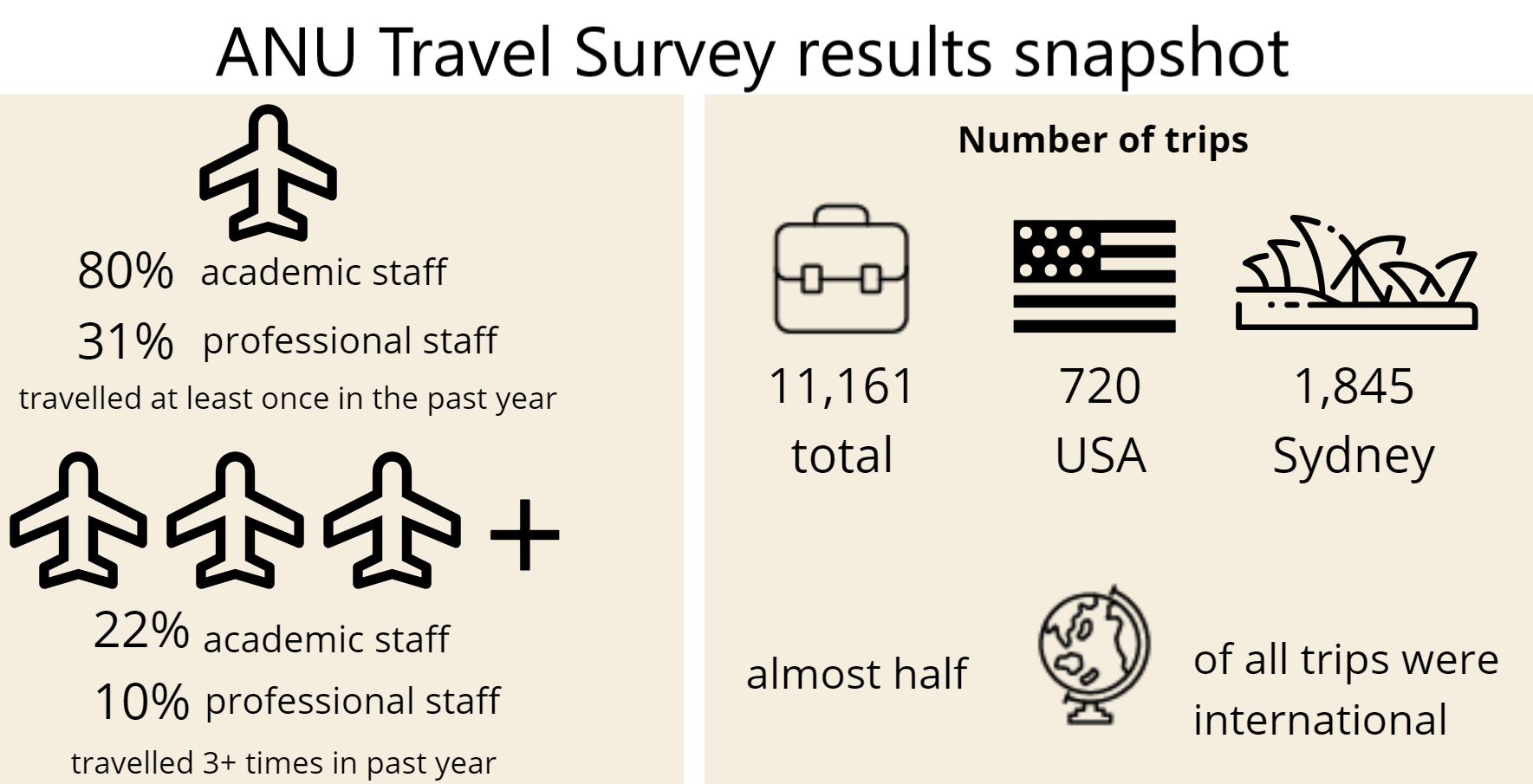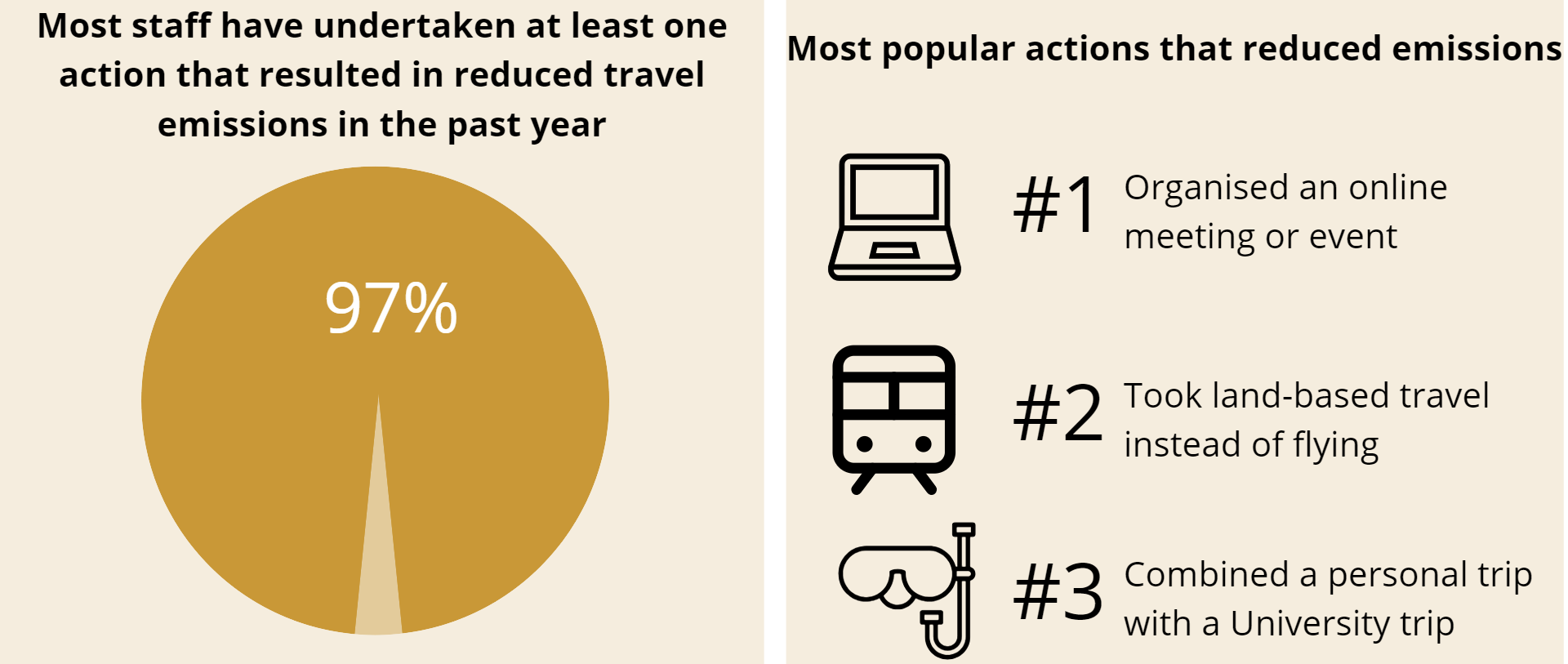
Almost a year ago, ANU set an ambitious goal to reduce travel emissions, marking a significant step in our action to address our contributions to climate change. The launch of our Travel Emissions Tracker, accessible to all ANU staff, has allowed us to see our travel profiles and gather insights into our progress.
Travel emissions are currently 29 per cent below the same period in 2019, a reduction in our carbon footprint by approximately 7,780 tonnes of CO2e for this first half of the year. While travel at ANU has been on a growth trajectory since the removal of COVID-19 restrictions, the latest figures demonstrate a deceleration in the bounce back.
All ANU Colleges have contributed to these significant emissions reductions. The College of Business and Economics (CBE) is tracking a 51 per cent reduction, with the College of Arts and Social Sciences (CASS) at 37 per cent and the College of Science (COS) at 29 per cent. Check out the Travel Emissions Tracker for your School or College travel emission profile.
This reduction in travel emissions was observed across all travel activities, even in areas where reducing emissions can be more challenging, such as field trips. These findings align with the outcomes of a staff survey conducted earlier in the year, which revealed that ANU staff are actively taking action to lower their travel carbon footprints.
What ANU staff have to say about reducing travel emissions
A recent survey of ANU staff shows that nearly all (97 per cent) said they had incorporated at least one activity within the past 12 months that contributed to reducing travel emissions. The most common action reported was organising an online meeting or event instead of attending in person (50 per cent of respondents). Respondents demonstrated widespread support for better access to resources facilitating online events and meetings and were open to receiving practical recommendations for reducing emissions from travel. Check out the figures below to see a snapshot of these survey results, or you can view a more detailed report here (PDF, 742.16 KB).
Some concerns voiced in the survey included apprehensions about extra administrative burden on staff in the travel process in the effort to reduce emissions from travel, as well as perceived conflicts arising from the expectation to travel less while still meeting job-related objectives. In an effort to reduce administrative burden, updates to the ANU travel process are being implemented including a new online system to replace the Travel eForm. Carbon smart travel considerations have already been embedded into ANU travel policy and handbook to ensure staff have the tools to succeed with a reduced carbon footprint. Additionally, we've reframed our messaging away from 'reduce travel emissions' to 'achieving our goals with carbon smart travel' to more accurately reflect a systemic approach necessary for success.


Looking ahead
An additional 21 per cent reduction in emissions from travel, equivalent to 5,400 tonnes of CO2e, is necessary to meet our target by the end of 2025. To support this goal, the ANU Below Zero team has developed the Carbon Smart Travel Guide in collaboration with ANU Travel Services, providing practical recommendations on reducing emissions from travel.
Practical takeaways for carbon smart travel include:
Take land-based travel where possible and safe, such as catching the bus or train from Canberra to Sydney instead of flying. This small step alone will save around 100 kilograms of carbon for a return trip between these cities.
Check emissions from different itineraries using online booking tools. In fact, Corporate Travel Management (CTM) – the University's current preferred booking service – has an online booking tool that provides CO2 emissions data for all flights. You can also sort options based on factors like emissions. To access the CTM online booking system, contact Shared Services - Travel.
Plan ahead. Planning your upcoming travel for the months or year ahead allows you to more easily prioritise your time, money and environmental impact, cutting down on last-minute and reactive travel. When planning your travel, you can use the simple calculation tool (Download Excel file, 2.7MB) which estimates flight emissions.1
Travel carbon smart everyday
In light of feedback from staff, ANU is investigating the impact of commuting as a contributor to the University's carbon footprint. Help us better understand those emissions across our community by taking the quick commuting and working from home survey when it appears in On Campus next week.
Want to help shape our approach?
We are working with schools and colleges to co-design measures that support our staff in being successful with a lower carbon travel footprint. Contact the Below Zero team to contribute to our climate action program.
Want to contribute to reducing your carbon footprint in other ways?
Check out the One Small Step app, developed to speak directly to the ANU community with easy and fun ways to act more sustainably. Head over now and start earning points by reducing your carbon footprint.
1The methodology for calculating emissions is consistent with the Travel Emissions Tracker, which uses recommendations in the business travel section of the Greenhouse Gas Protocol, a globally acknowledged standard for measuring and managing greenhouse gas emissions.